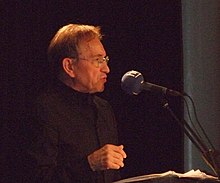Neuhessischer Regiolekt

Neuhessisch is a German Regiolekt that is spoken in central and southern Hesse . Colloquially it is often referred to as "Hessian", although it is much closer to the standard German language than to the traditional Hessian dialects .
Linguistic classification
The regional language development that occurred in the course of the 20th century has led to a "Rhine-Mainization" of southern Central Hessian in the Rhine-Main area . The old linguistic structural boundaries have been broken down and have led to a reorganization of the language area. From a linguistic point of view, one speaks of the Rhein-Main-Regiolekt instead of "Neuhessisch".
New Hessian and Hessian dialect in media and culture
The colloquial language of the Rhine-Main area , which is colored in southern Hesse, has gained national fame through radio and television, especially through the Hessian broadcasting company based in Frankfurt am Main . In the 1960s and 1970s popular, nationally successful television programs such as Heinz Schenk's Zum Blauen Bock or Die Hesselbachs with Wolf Schmidt and Liesel Christ shaped the impression of Hessian dialect. What is nowadays often seen as a “typical Hessian dialect” outside Hesse is actually the regiolect of the South Hessian Rhine-Main area, which developed in the second half of the 20th century.
Even in 1976 resulting multi-part television production of the hessian broadcast Winter, who was a summer , inter alia, in Kassel and Treysa plays, the actors use in dialect passages predominantly of non-native South Hessian dialect. In order to differentiate New Hesse from the traditional dialects of Central Hesse and North Hesse, the term TV Hessian or Ebbelwoi Hessian is used.
New Hessian is also used by modern South Hessian dialect authors such as Kurt Sigel , Ernst Schildger or Fritz Ullrich ( Frankfurter Rundschau ) and writers such as Rudolf Krämer-Badoni (Germany - your Hesse) and Herbert Heckmann . The Darmstadt-born actor Günter Strack was repeatedly seen in South Hessian dialect roles , for example in the film series Hessian Stories , in which Strack embodied various popular characters, or the series Die Drombuschs , Mit Leib und Seele . The Frankfurt Volkstheater , which existed from 1971 to 2013, played numerous modern theater pieces in dialect.
The playwright, director and actor Wolfgang Deichsel, with his Moliere adaptations in the Frankfurt dialect, was literarily significant for the modern Hessian folk theater . They have been performed in the Theater am Turm and the Schauspiel Frankfurt since the 1960s , today mainly by the Frankfurt Volksbühne and at the Barock am Main theater festival . Well-known actors and cabaret artists from New Hesse include Michael Quast , Matthias Beltz and Walter Renneisen .
Popular culture
More recently, groups such as Saure Gummern (Ried-Blues), the rock band Rodgau Monotones , the comedy groups Badesalz and Mundstuhl as well as the comedians Bodo Bach and Maddin , but also the cabaret artist Urban Priol from the border with southern Hesse, have determined the Aschaffenburg, which belongs to the Bavarian administrative district of Lower Franconia, and Rainer Bange from Hanau, the regional lecture scene in southern Hesse.
You can also include the rap group Rödelheim Hartreim Projekt here. A Hessian-High German Missingsch is used here. The regional lectures presented are predominantly New Hessian on Frankfurt and also South Hessian substrate, the forms of which are spoken in the Frankfurt , Mainz , Wiesbaden , Offenbach , Hanauer, Aschaffenburg and Darmstadt areas, or High German tinged with Rhenish Franconia.
The regional base dialects of Central and Upper Hesse are merging into a developing New Hessian along with economic traffic relations (mockingly: " RMV- Hessian") in the south.
Other Regiolects in Germany
literature
- Heinrich J. Dingeldein : Basics of a grammar of Neuhessischen. In: Building bridges. “Far out on your own two feet.” Festschrift for Fernand Hoffmann. Edited by Joseph Kohnen, Hans-Joachim Solms and Klaus-Peter Wegera. Lang, Frankfurt am Main 1994, pp. 273-309, ISBN 3-631-47300-1 .
- Hans Sarkowicz, Ulrich Sonnenschein (Ed.): The great Hessen. Insel, Frankfurt a. M. / Leipzig 1996 (HR production), ISBN 3-458-16817-6 .
- Lars Vorberger: Regional language in Hesse. An investigation into language variation and language change in central Hesse (= Journal for Dialectology and Linguistics. Supplement 178). Stuttgart 2019, ISBN 978-3-515-12363-1 .
Web links
- "Reimtext" , Frankfurt (incl. Videos and song samples)
Individual evidence
- ^ Lars Vorberger: Regional language in Hesse. An investigation into language variation and language change in central Hesse (= Journal for Dialectology and Linguistics. Supplement 178). Stuttgart 2019, ISBN 978-3-515-12363-1 .